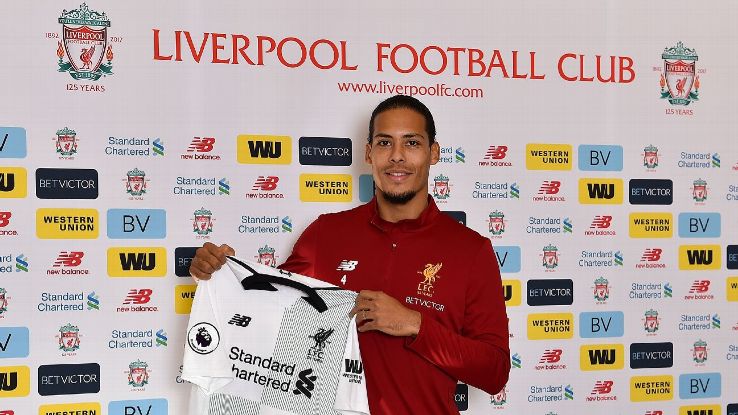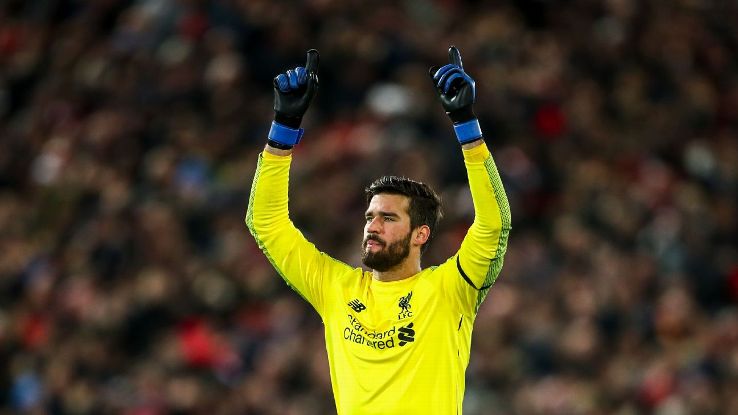LIVERPOOL, England — Believe it or not, there can be certain drawbacks to having sustained success in the transfer market.
Liverpool’s revamped approach and methodology to recruitment in recent years has the team well-placed to end its 28-year wait for a league title this season. But in doing so, sources have told ESPN FC that when Liverpool come calling for a player, the selling club can often hesitate, wondering whether their valuation of their player will quickly be perceived as a bargain in a matter of months.
Those concerns are well-founded. Mohamed Salah, Sadio Mane and Andrew Robertson are just three recent Liverpool additions to have enjoyed rapid trajectories to stardom in their first season at the club. The Reds also had six players — five of whom were signings under Jurgen Klopp — in 2018’s FC 100, their highest-ever mark.
Because of their strike rate, Liverpool also have fears that their interest in a player emerging can tip off a potential rivals. Opposing clubs can begin to second-guess their transfer strategy if said player is not on their radar. If Liverpool are interested, should we be too?
Yet it wasn’t always that the Merseyside club led from the front in the transfer market. It’s not even been half a decade since Liverpool’s ill-fated, scattergun summer transfer window of 2014, arguably their lowest point of the modern era when it comes to signings and sales.
The dysfunction between then manager Brendan Rodgers and the club’s transfer committee was clear. Mario Balotelli would end up being signed to boost Rodgers’ attacking options after Luis Suarez left for Barcelona — just weeks after Rodgers had “categorically” ruled out a move for the controversial striker. Alexis Sanchez had originally been the club’s No. 1 target before attention was then turned to Loic Remy. 32-year-old Rickie Lambert was signed the same summer.
Lambert and Balotelli combined for just three goals in the Premier League. Meanwhile, it took Salah six league appearances in a Liverpool shirt to exceed that total; Mane only needed nine.
There are other examples after that summer, too. The signing of Christian Benteke for £32.5 million in 2015 was questioned within Melwood, regarding his suitability to Liverpool’s style of play. That same summer, Roberto Firmino was bought for £29m from Hoffenheim but used sparingly by Rodgers, who was dismissed months later.
In that period, certain signings could be categorised as “Rodgers players” and others as “committee players.” The concept of such terms painted the discord at the club, as did the fact such was common knowledge in the public domain. Now, under Klopp, there is joined-up thinking when it comes to transfers, which is ultimately what has made the difference in their proficiency. Egos are checked at the Melwood gate by Klopp and sporting director Michael Edwards, as well as from across the Atlantic by director Mike Gordon.
Edwards, made director of football in November 2016, plays a leading role but prefers to do so away from the spotlight. In May, he turned down the chance of a photo on the red carpet at Liverpool’s player awards at Anfield while other staffers had theirs taken. His designated car parking space at Melwood is often vacant because of assignments.
Meanwhile Gordon, Fenway Sports Group president, can amaze staff at Liverpool with his knowledge about the club and the footballing world. “Mike knows everything,” a source said. “Wow.”
It is this holy trinity of Klopp, Edwards and Gordon that has assembled this Liverpool squad, which is currently full of proven superstars and potential world-beaters. Dissonance and dysfunction have been replaced by logical, thorough plans and measured approaches at Anfield. Proof of their success so far is clear just by looking at the table — the Reds have a seven-point lead over Manchester City ahead of Thursday’s blockbuster trip to the Etihad, albeit with 18 games left to play.

So how does their new approach work?
One source estimated that Liverpool will have their plans for a particular window locked and loaded around eight to 12 months in advance. The blueprint? Identify players who are hungry, are characterized as “good people,” boasting quality but still with room to grow and who are perhaps misused at their current clubs. They have been the hallmark traits of Liverpool signings since Klopp walked through the door in October 2015.
Their list has a few immoveable targets. Liverpool cleverly worked a way around RB Leipzig’s reluctance to sell Naby Keita and still ensure his signature, while a fractured relationship with Southampton amid allegations of tapping-up could not stop them from eventually landing Virgil van Dijk. But there does, of course, have to be a degree of flexibility in what are fluid markets. There are the times when Liverpool’s best-laid plans fall apart but still work out. Prime targets still may not always be secured, but Liverpool have shown they are worlds away from the Sanchez-then-Balotelli summer when dealt a blow.
In fact, arguably Liverpool’s most successful signing of the decade was an alternative.
Bayer Leverkusen winger Julian Brandt was a prime forward target in the summer of 2017, sources have told ESPN FC. But after the German speedster expressed concerns about his opportunities at Anfield, Liverpool turned their attention towards a player long on their radar and enjoying a renaissance in Rome. Had Liverpool not be able to prise Salah away from Roma, then Keita Balde Diao was another player the club planned to pursue instead.
Then there’s the case of Mane, arrived in 2016 after Mario Gotze passed up the chance to work with Klopp again, according to sources. Leroy Sane, now of Man City, was also a target that summer while Robertson, an £8m arrival from relegated Hull City in 2017, was seen as the back-up option to bigger targets Emerson Palmieri, who played for Roma at the time, and Fulham teenager Ryan Sessegnon.
Liverpool also tried to pounce upon Christian Pulisic’s lack of opportunities at Borussia Dortmund in August 2016. Back then, Dortmund were open to a loan move for the 17-year-old in a bid to aid his development but rejected Liverpool’s €13m purchase offer. Sources have told ESPN FC that the player and his family did want to move to Liverpool at that moment but the German giants did not want to sell, promising (and eventually delivering) the U.S. international more game-time.
Such fluidity has been evident in other smaller, but no less influential, purchases. In Alex Oxlade-Chamberlain, Liverpool found a midfielder — “one of the most outstanding performers in European football,” according to Jurgen Klopp at the time of his knee injury — hiding in plain sight at Arsenal.
Ultimately, Liverpool have put themselves in a position to attract these talents who become the envy of rivals because of their year-round transfer operation. It’s a full-time job, not just work done when the windows are open twice a year.
For example, the club were able to beat Real Madrid and Chelsea to the signature of Alisson. When Roma’s asking price for the Brazil No. 1 was considered too high, Liverpool remained in close contact with the goalkeeper’s agent, Ze Maria Neis, laying the foundations if Roma were to lower their valuation. It meant that when Roma’s stance softened in July, Liverpool were in a position to pounce while Chelsea and Real were still dealing with uncertainty surrounding Thibaut Courtois’ situation.

Sources have said that Liverpool recognise the increasing importance of making players feel wanted and valued when it comes to the transfer market. Georginio Wijnaldum, in particular, was impressed with the speed in which Liverpool wrapped up a deal with Newcastle United in 2016. Wijnaldum had held discussions with Tottenham Hotspur earlier in the summer of 2016.
“When I spoke with Jurgen, four days later I was a Liverpool player,” the midfielder told reporters in Hong Kong in 2017. “Three days after our meeting, they’d reached a deal and that gave me a good feeling, as well.”
The identification of these players is not just based on footballing ability alone. Liverpool’s management place a huge amount of importance on the personality of a player, a standard that applies at all levels of the club. Liverpool’s recruitment department gather intel on the background of a potential signing, speaking to their former coaches and teammates.
“I think the club are very sensible in how we recruit — at all levels,” under-18s coach Barry Lewtas told ESPN FC. “It’s very meticulous.
“I think that’s very obvious from what the first team do and, I’d say, at the academy level. They’re very meticulous in terms of getting the right people in. I’m clear about that: the right people. That’s important. And we want the right players as well.”
Like he did at Borussia Dortmund, Klopp has creative this Liverpool team with a group of emerging and hungry players. James Milner and Daniel Sturridge are the only current Reds to have managed to get their hands on the Premier League title. Xherdan Shaqiri is the only Champions League winner. Salah, Mane and Firmino have been happy to sign new long-term contracts in recent months, believing Anfield is the best place for their own development and that trophies will soon follow.
Departures, too, have been another area of significant improvement. Players leaving — whether permanently or on loan — are now exiting on Liverpool’s terms.
“The people at Liverpool are merchants, not Samaritans,” former Wolfsburg sporting director Olaf Rebbe said when attempting to sign Divock Origi on a permanent basis midway through his recent loan spell in the Bundesliga.
Liverpool begrudgingly sold Philippe Coutinho to Barcelona but took preventative steps to ensure no other key men made to move from Anfield to the Camp Nou any time soon. Reports suggest Barcelona will have to pay a €100m premium if they were to sign another Liverpool player before 2020.
“I can’t say I’ve encountered a clause like this in any of the transfer agreements that I’ve dealt with,” leading sports lawyer Tiran Gunawardena told ESPN FC.
Now possessing a ruthless streak in the transfer market, a club that was routinely mocked for their business not so long ago is now leading the way in it. Expect it to continue.
